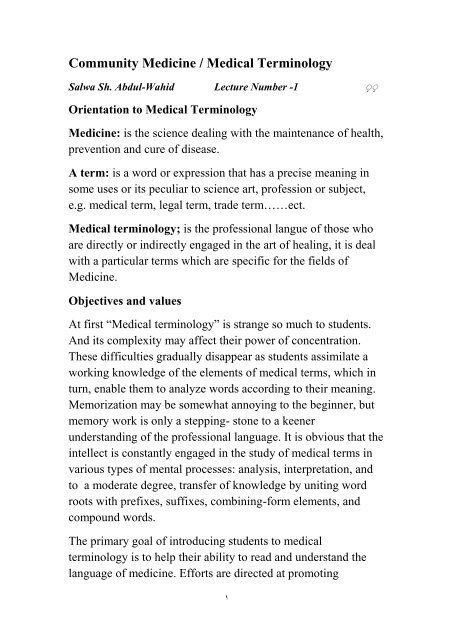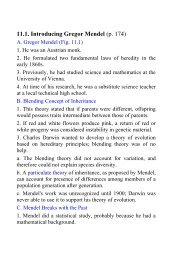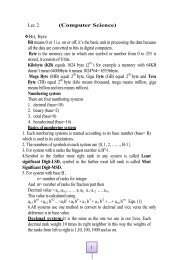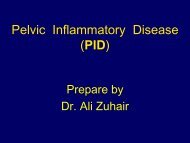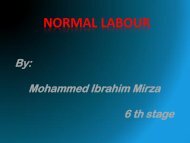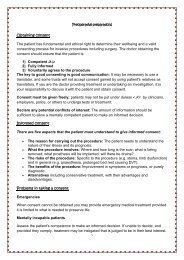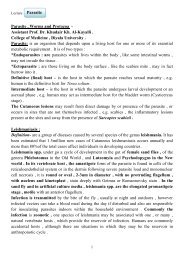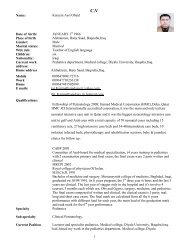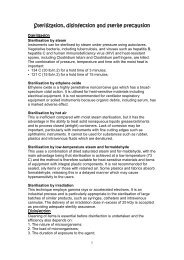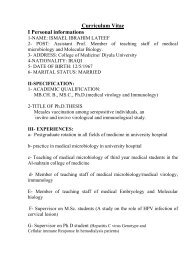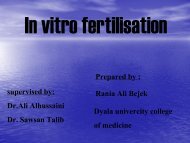Community Medicine / Medical Terminology
Community Medicine / Medical Terminology
Community Medicine / Medical Terminology
You also want an ePaper? Increase the reach of your titles
YUMPU automatically turns print PDFs into web optimized ePapers that Google loves.
<strong>Community</strong> <strong>Medicine</strong> / <strong>Medical</strong> <strong>Terminology</strong>Salwa Sh. Abdul-Wahid Lecture Number -1ٍ ٍOrientation to <strong>Medical</strong> <strong>Terminology</strong><strong>Medicine</strong>: is the science dealing with the maintenance of health,prevention and cure of disease.A term: is a word or expression that has a precise meaning insome uses or its peculiar to science art, profession or subject,e.g. medical term, legal term, trade term……ect.<strong>Medical</strong> terminology; is the professional langue of those whoare directly or indirectly engaged in the art of healing, it is dealwith a particular terms which are specific for the fields of<strong>Medicine</strong>.Objectives and valuesAt first “<strong>Medical</strong> terminology” is strange so much to students.And its complexity may affect their power of concentration.These difficulties gradually disappear as students assimilate aworking knowledge of the elements of medical terms, which inturn, enable them to analyze words according to their meaning.Memorization may be somewhat annoying to the beginner, butmemory work is only a stepping- stone to a keenerunderstanding of the professional language. It is obvious that theintellect is constantly engaged in the study of medical terms invarious types of mental processes: analysis, interpretation, andto a moderate degree, transfer of knowledge by uniting wordroots with prefixes, suffixes, combining-form elements, andcompound words.The primary goal of introducing students to medicalterminology is to help their ability to read and understand thelanguage of medicine. Efforts are directed at promoting1
knowledge of elements of medical terms, understandingslandered abbreviations, being able to spell medical terms andappreciating the logical method found in analyzing medicalterms.Basic ConceptsThe majority of medical terms from Greek and Latin ancestry.Some have been adopted from modern language, especiallyGerman and French. The study of medical terminology canenrich one’s understanding of history, language and medicineIn analyzing terms, students need to understand the key conceptsthat will enable them to break terms into their componentelements (e.g., identifying roots, prefixes, suffixes, combiningform elements, and compound words). The following listpresents these key concepts:1- Root or base word element – refers to the main body ofthe word. It may be accompanied by a prefix or suffix.2- Example: adenomaAden= (base or root) = glandOma = suffix = tumorAdenoma = gland tumor2-Prefix – refer to one or two word parts placed before aword to modify or alter its meaning.Example: hemigastrectomyHemi= prefix = halfGastr (base or root) = stomachEctomy = (suffixe) = removal of half the stomach3-Suffix – one or two of word parts attached to the end of aword to modify or alter its meaning.2
<strong>Community</strong> <strong>Medicine</strong> / <strong>Medical</strong> terminologySalwa Sh. Abdul-Wahid Lecture Number -2ٍ ٍTerms of positionsAb = away e.g. Abnormal= away from normal.Abduction: away from midline.Ad =toward e.g. Adrenal gland which is the endocrine glandabove the kidney.Adduction = is to move a limb toward the midline.Trans = across e.g. Transected ultrasound. Transparent orTranslucent= you can see through.Para = near, beside e.g. percutaneous cholangiography which isthe radiological visualization of biliary passage by injection of adye through skin into the biliary passage of the liver. Medial =toward the midline. The ulnar nerve occupies a medial positionin the forearm.Median = in the middle. The median nerve is in the middle ofthe forearm. The mediastinum is the space in the middle of thethorax between the plural sacs and the lungs. The Median asarithmetic statistical value which is the value in an ordered setof values below and above which there is an equal number ofvalues.Lateral = to the side .e.g. lateral neck swelling is a swelling atthe side of neck. The radial nerve occupied a lateral position inthe forearm.Supra, Super = above, beyond e.g. Supraorbital swelling=above the orbit.3
Supraspinatus muscle is above the spinous process of thescapula. Superficial = close to the surface.Superimposed= placed above.Peri = around (peritoneum, pericardium, periosteum) = whichare the sheaths around the abdominal viscera & above the bone.Pro = forward, e.g. prothrombin =protein that generatethrombin. Promyelocyte =precursor cell of myelocyte in whiteblood cells (WBC ) formation.Sub = under e.g. Subcutaneous = under the skin,Sub mucosal = under the mucosa.Dextro = right e.g. Dextrocardia = the state of the heart on theright side of the thorax.Levo, sinstro = left e.g. Levorotation, sinstrocardia,sinstrocerebral = related to left cerebral hemisphere.Dia = across e.g.Diapedesis = passive movement of red bloodcells ( RBC) across blood vessel wall.Infra = below e.g. Infraorbital foremen a hole below the orbit.Dorsal = toward the back.Ventral = toward the abdomen.Apex = Tip, Summit, e.g. the upper part of the lung is apex.Base = bottom = lower part.Inter = between e.g. interdigital cleft.Supine = lying face up.Prone = lying face down.Proximal = the part closest to source of origin.Distal = the part farthest from the source of origin.4
<strong>Community</strong> <strong>Medicine</strong> / <strong>Medical</strong> terminologySalwa Sh. Abdul-Wahid Lecture Number -3ٍ ٍTerms of Colors / PrifixesChromo, chromato = colore.g. a chromogenic substances = color producing substancesalb/o = whitee.g. albino, albinism = white skin and hair due to absent melaninchlorophyll (chloro/o) = greene.g. chlorine is a halogen that is isolated as a greenish gas.Cyano = bluee.g. cyanosis is blue skin, due to decrease oxygen in blood.Erythro = red, e.g erythrocytes are the red blood cell.Erythema = red cellErythropoiesis = is the process of RBC formation.Leuk/o = white. E.g. leukocytes, the white blood cells.Leukaemia = malignancy of WBC.Melano = Black. E.g. melanin is the brown black pigment of skin.Melanocytes, are cells at the basal layer of epidermic synthesis melanin.Xantho = yellow, e.g. xanthoma = malignant lesion of skin .xanthochromic fluid = like plural, ascetic fluid.Polio = Gray matter of spinal cord.Purpura = purple, e.g. purpra; cutanous haemorrhage inthrombocytopenia.Aures = Golden, staphylococcus, is golden colonies.5
<strong>Community</strong> <strong>Medicine</strong> / <strong>Medical</strong> <strong>Terminology</strong>Salwa Sh. Abdul-Wahidٍ ٍLecture Number -6&7Musculoskeletal DisordersBonesOrigin of TermsCalcanus (L)* = heel boneCancellus (L) =latticCoxa (L) = hipe boneDi (G)** = twice, doupleDia (G) =through , betweenDiplo (G) = foldFemer (G) =thighGenu (L) = kneeAnatomic TermsBone, osseous tissue = hardest type of connective tissue, which provide asupporting framework of the body.Bone marrow, medulla = soft, central part of the bone.Red marrow –fill cancellous bone and manufactures red blood cells andhaemoglobin.Yellow marrow = fills the medullary cavity and contain fat cell.Compact bone, cortex of bone = solid bone rich of calcium......................................................* L= Latin in origin**G = Greek in origin8
Diaphysis = shaft of long bone.Endostum = membrane lining the walls of medullary cavity.Epiphysis =extremity of long bones and centre of ossification for growingbone.Medullary cavity = marrow filled cavity within the shaft of long bone.Metaphysis =enlarged part of the shaft near the epiphysis of long bone.Ossification = bone formation.Osteoblast = bone forming cells.Periostum = outer covering of the bone.Diagnostic TermsAneurysmal bone cyst = solitary vascular lesion that usually arise frommedullary or cancellous structures.Hemangioma = commen benign vascular tumor of bone.Fracture = broken bone.Genu valgum = knock – knee.Genu varum = deformity involving either tibia alone or femur. Seen inrickets and corrected by high dose of vitamin- D.Osteomalacia = softening of the bone.Osteomyltis = inflammation of the bone and bone marrow.Operative TermsAmputation = partial or complete removal of the limb, necessitated bycrushing injury, gangrene, vascular obstruction, or uncontrolled infection.Bone graft , transplantation of bone = insertion of bone graft.Osteoctomy = excision of bone.Osteoplasty = reconstruction or repair of bone.9
Symptomatic termsCrepitation = grating sound made by movement of fracture bone.Decalcification = removal of lime salts, especially from the bone.Deminirization = deficiency or loss of bone minerals that occur inosteoporosis, osteomalacia, cancer or other disorder.Joint, Bursa, Cartilages and ligamentsOrigin of termsArth, arthro (G) = jointBursa (L) = sac, saclike coming,Chondr, chondro (G)=cartilageLigamentum, (L)= that which ties, tissue that binds.Scolio (G)= twistedSpondyl, spondylo (G)= vertebra, spinal columVertebro (L)= vertebra, spinal columAnatomic termsAcetablum =cup shape socket on external surface of bone in which thehead of the femur lies.Articulation = jointLigament = fibrous, connective tissue, bands uniting articular ends ofbone.Diagnostic termsAnkylosis = stiff joint.Arthritis = inflammation of jointHemarthrosis = bloody effusion in a joint cavitySpondylosis = ankylosis of vertebra, also any degenerative lesion ofspine.11
Sprain = injury of joint with tearing of tendons and ligaments.Symptomatic termsArthralgia, arthrodyna = joint pain.Capsular laceration = tear of joint capsule.Diaphragm, muscles and tendonsOrigin of termsFacia (L) =bandMy, myo(G)= muscleLeio (G) =smoothTeno , tendo =tendonAnatomic termsDiaphragm = the muscular dome shaped septum between the thorasic andabdominal cavity.Fascia = sheet of connective tissue that cover the muscles.Muscle =contractile tissue composed of units that have the power tocontract when stimulate by nerve impulse.Tendon = band of fibrous tissue that attached muscles to bones.Diagnostic termsDisuse atrophy = muscle wasting caused by immobilization.Symptomatic termsClonic spasm = rapid repeted muscle contractions.Cramp = prolong intense spasm of one muscle.Hyperkinesia = purposless excessive movementHypotonia = reduce muscle tension, associated with muscle atrophy.Rigidity, rigor = stiffness, muscular hardness.Tonic spasm =excessive, prolonged muscular contraction.Tremors =oscillating, rhythmic movement of muscle group.11
<strong>Community</strong> <strong>Medicine</strong>/ <strong>Medical</strong> <strong>Terminology</strong>Salwa Sh. Abdul-Wahid Lecture Number 8&9ٍ ٍCardiovascular DisordersHeart and Coronary ArteriesOrigin of TermsAngi; angio –G* = vesselApico ; -L** =top, summitAtrio; - L =chamber, hallBrady; G =slowCard; cardio – G = heartCor; - L = heartDextro;-L =rightEmia;-G=bloodHem , hemo;-G= bloodMy, myo;-G=musclePathy –G=diseaseSeptum –L=dividing wall, partitionStetho –G=chest.Tachy –G=rapid, swiftVeno –L= vein.Ventriculo –L=belly, ventricle………………………………….*G = Greek in origin,**L=Latin in origin12
Anatomic TermsCavities of the heart =the four heart chambers.Atria (sing. Atrium) = two chambers that form the base of theheart and receive venous blood.Ventricle = two chambers that lie anteriorly to the atria andpropel blood into arteries.Conduction system of the heart = neuromuscular tissuespecialized for the conduction of electric impulses.Heart and wall covering:-endocardium =interior lining of the heart wall.-myocardium =the heart muscle.-pericardium =covering of the heart composed of a fibroustissue (pericardium fibrosum), and serous tissue (pericardiumserosum).Atrioventricular orifices and valves between atria andventricles.Coronary arteries =branches of ascending aorta arising fromthe right aortic sinuses.Diagnostic TermsAngina pectoris: syndrome characterized by short attacks ofsubsternal pericardial pain that radiates to left shoulder andarm.Atrial septal defect: abnormality resulting in a shunting ofoxygenated blood from the left into right atrium.Cardiac arrest: cessation of effective heart action.13
Cardiac arrhythmias: irregularities of heart action.Symptomatic TermsBradycardia =slow heart action.Cardiac edema =retention of water and sodium incongestive heart failure due to circulatory impairment.Cardiac syncope=fainting associated with marked suddendecrease in cardiac output.Murmur =blowing sound of the heart muscle.Tachycardia =rapid heart action.Palpitation =increasing heart rate.Arteries, capillaries, veinAngio, angio,-G= vesselSystole,G=contractionarterio,G=arterypulsus, L=stroke, beatthrombo, G=clotphleb, phlebo,-G=veindiastole, G=expansionveno, L=veinsclera,G=hardhemangio, G=blood vesselAnatomic TermsAorta =main artery of the trunk.Arteries =elastic vessels that carry blood away from theheart and distribute it to various parts of the body.Veins =vessels that return blood to the heart.Capillaries=microscopic vessels that connect arterioles onthe venules.14
Blood pressure-systolic =force exerted by blood against the arterial walls as theend of the contraction of the left ventricle.-diastolic= force exerted by blood against the arterial walls atthe end of the relaxation of the left ventricle.Diagnostic TermsAcute limb ischemia =sudden catastrophic interruption ofblood flow to an extremity, demanding reversal by surgery orclot lysis to save the limb.Aneurysm of aorta= irreversible dilatation of a weakened partof the wall of vessel.Arteriosclerosis=degenerative, vascular disorder characterizedby a thickening and loss of elasticity of arterial walls. It affectssmall arteries and arterioles and seems to be secondary tohypertension.Hypertension =pathologic elevation of the blood pressure.Phlebitis =inflammation of the veins.Phlebosclerosis =hardening of the veins.Thrombosis =formation of blood clots in a blood vessel.15
<strong>Community</strong> <strong>Medicine</strong> / <strong>Medical</strong> <strong>Terminology</strong>Salwa Sh. Abdul-Wahid Lecture Number (10)ٍ ٍDisorders of the Blood & blood forming OrgansBlood,Origin of termsAniso –G* = unequal, dissimilarApheresis, pheresis –G- =removalBlasto –G-= germCyt, cyto –G = cellEima –G =bloodHema , hemato, hemo –G- =BloodMegalo –G- = LargeMyel, myelo –G =marrowOsis – G = increase, disease, conditionPenia –G = deficiency, decreasePhage , phagia –G- to eatPhoresis –G = being carried, transmissionPlasma –G = plasma, cell substancePoiesis –G = to make, formationPoikilo –G = varied, irregularPolymorph –G =many forms16
……………………………………..*G = Greek in originReticulum - L** = networkSidero –G =ironSphero –G = round, ball, sphereTerms related to blood elements and blood groupingsBlood = consists of a liquid portion called plasma and a solidportion that includes red blood cells (erythrocytes), white bloodcells ( leukocytes), and platelets.Blood group or blood type = inherited characteristics of humanblood that remains unchanged throughout life .Cross matching =procedure done to determine the compatibilitybetween the recipient’s blood and donor’s blood to preventblood transfusion reaction.Incompatible blood = blood that cannot be mixed withoutcausing hemolysis or clumping of red blood cells.Universal blood donor= blood type (O) blood has noagglutinogens, hence clamping does not occur.Erythroblasts = immature red blood cells, possess a nucleus andare present in fetal blood.Erythropoiesis = entire process by which red blood cells areproduced in the bone marrow.Hemoglobin = chemical component of erythrocytes containingtwo substances, globin, a portion, and heme, an iron –containingportion responsible for the transport of oxygen to the cells.…………………………………………..17
**L=Latin in origion<strong>Community</strong> <strong>Medicine</strong> / <strong>Medical</strong> <strong>Terminology</strong>Salwa Sh. Abdul-Wahid Lecture Number 11 &12Respiratory DisordersNose, Paranasal sinuses, LarynxOrigin of termsChoana –G* = FunnelConcha –L** = ShellMeatus –L = passage, partition of mucous membraneNaso –L = noseOsmo –G =sense of smellPharyngo- G=pharynxRhino –G =noseSeptum –L=partitionSinus –L=hollowLarynx –G= larynx, voice boxAnatomic Terms:Naries = nostril.Nasal meatus =space beneath each concha of the nose.Nasal septum =partition between the two halves of the nasalcavity.…………………………………………18
*G = Greek in origin**L=Latin in originNaso-pharynx =open chamber located behind the nasal fosseand below the base of the skull.Frontal sinus =air space in the frontal base above nasalcavity.Diagnostic TermsAtresia of choanae =malformation in which the opening ofthe nasal cavity into the nasopharynx isobstructed by a partition of mucous membraneand bone.Coryza = cold in head.= result from developmentNasal polyp = benign lesion that may cause obstruction ofthe nasal cavity.Nasal sepal deformities = result from developmentanomalies or truma at birth or later in life andproduce nasal obstruction with sinusitis.Nasopharyngitis = inflamed condition of nasopharynx.Rhinitis =inflammation of nasal mucosa.Allergic rhinitis =hay feverSinusitis =inflammation of sinus or sinuses.Pansiunitis = inflammation of all sinuses.Symptomatic termsAnsomia = absence of smellEpistaxis –nosebled19
Rhinorrhea =thin watery discharge from nose.Aphonia =loss of voice due to local disease, hysteria , orinjuryDysphonia =difficulty in speaking, hoarseness.TracheaOrigion of termBi-L =twoFurca –L=forkSteno –G=narrow, contractedTrachea –G=rough, tube likeAnatomic termsBifurcation =division into two branchesCarina =ridge between the trachea at the bifurcation.Trachea =tube like structure composed of about 18 c-shapedcartilages, held together by elastic tissue andsmooth muscle and extending from the larynx tobronchi.Diagnostic termsClassification of tracheal rings =deposit of calcium intrachea.Stenosis of trachea =contraction or narrowing of lumen oftrachea.Tracheobronchitis =inflammation of bronchi and trachea.Trachea-esophageal fistula =communication of esophaguswith traches, congenital or acquired anomaly.21
BronchiBronchus –L=winpipeBronchiolus-L= air passageAnatomic termsBronchi (sing bronchus), main two primary divisions, one toeach lung,(right main bronchus, left mainbronchus).Bronchioles, bronchioi=smaller sub divisionLungsOrgin of termsAlveolus –L =small saclike dilatation.Apex of the lung, base of lungLobe=major division of lungDiagnostic termsAbscess of lungAplasia of the lung =incomplete development of the lung.Pneumonia =disease of the lungPnemonitis =inflammation of the lungSymptomatic termsAnoxemia =deficient oxygen tension in arterial bloodAnoxia =oxygen want in tissue and organThorax , pleura and mediastinum21
Mediastinum=interplural space containing the pericardium,heart, major vessels, esophagus and thoracic duct.Pleura =thin sac f serous membrane that invaginated by thelungs. Each lung has its plural sac.22
<strong>Community</strong> <strong>Medicine</strong> / <strong>Medical</strong> <strong>Terminology</strong>Salwa Sh. Abdul-Wahid Lecture Number 13Urogenital DisorderKidneysOrigin of termsCalyx (G) –cupCortex (L)-rind, outer portionGlomerulus (L)-tuft, clusterMedulla (L)-marrow, inner portionNephr, nephro (G)-kidneyRen (L) –KidneyAnatomic tremsKidneys –paired, bean-shaped organs situated behind the peritoneum onboth sides of the lumbar spine. Their function is to preservethe ionic balance of the blood and extract its waste products.Nephron – the functional unit of the kidney. Each nephron consists of arenal corpuscle and renal tubule.Renal carpusle –composed of a tangled cluster of blood capillaries calleda glumerulus, which is surrounded by a thin saclike structurecalled a glomerular capsule (Bowman’s capsule).Renal cortex – outer portion of the kidney. It forms a shell around themedulla.Renal medulla – composed of conical masses of tissue called renalpyramids, whose bases are directed toward the convexsurface of the kidney, and whose apexes form the renalpapillae.Renal pelvis – funnel –shaped enlargement of the ureter as it leaves thekidney pelvis.23
Diagnostic terms:Nephrolithiasis, renal calculi – stone in the kidney.Nephropathy – any disease of the kidney.Pyelonephritis :infectious inflammatory disease that involve both theparenchyma and the pelvis of the kidney.Operative termsNephrectomy – excision of kidney,Nephrolithotomy – incision in the kidney for removal of stones.Nephrolysis – surgical destruction of renal adhesion.Symptomatic terms:Anuria – total suppression of urine due to renal failure or blockage ofurinary tract,UretersOrigion of termsHydr; hydr (G)- waterJunction (L)- joiningPyelo (G)- pelvis, tubPyo(G)- pusAnatomic termsUreter – muscular distensible tube lined with mucus membrane. It carriesurine from each kidneyBladder and urethraBulb (L)- enlargement or rounded massCysto (G)-bladder , sac.24
Meatus (L)- passage, opiningAnatomic termsBladder, urinary- a hollow muscular distensible organ. It serves astemporary reservoir urine.Urethra – fibro-muscular tube between the urinary bladder and externalurethral orifice.Diagnostic terms:Atony of the bladder- enormous distention of the bladder associated withreduced expulsive force.Urethritis – acute or chronic inflammation of urinary bladder.Operative termsCystectomy –excision of bladderm either partial or radical.Cystolithotomy – incision into the bladder for removal of stones.Symptomatic termsAlbumin urea – albumin or protin in urine.Dysuria – difficult or painful urination .Glycosurea –suger in urine.Hematurea – blood in urine.Micturition – urination.Oligurea –scanty urinary out put.Poly urea – excessive urinary output. Pyurea – pus in urine.25
<strong>Community</strong> <strong>Medicine</strong> / <strong>Medical</strong> <strong>Terminology</strong>Salwa Sh. Abdul-Wahid Lecture Number 14&15Digestive DisordersStomachOrigin of terms:Dudeno = duodenumFundus = basepyloro; pylors = gate keeperruga ;ruge =foldGastr ; gastro =stomachsphincter -binder encircling band of muscle fibersJejuno =jejunumMyo =muscleAnatomic TermsAntrum; gastric =distal nonacid secreting segment ofstomach or pyloric gland region that produces gastrinBody of stomach =largest portion of the stomach,between the antrum and fundusCardia =small area of the stomach near esophago -gastric junction.Cardiac orifice =opening at the junction of theesophagus and stomach.Cardiac sphincter = cardio-esophageal sphincter=muscle fibers about the opening of the esophagusinto the stomach.26
Diagnostic Terms:Gastric malignant neoplasm: (carcinoma; lymphoma)Gastric polyps: lesion that project above the surfaceof the surrounding mucosa or submucosa.Gastric ulcer: localized erosions of gastric mucosathat may result from digestive action of gastric acidsecretion. Gastritis: acute or chronic inflammation ofgastric mucosa.Gastrocele: hernia of the stomach.Gastrocolitis: inflammation of the stomach & colon.Gastrodudenitis: inflammation of the stomach&duodenum.Gastroenteritis: inflammation of the stomach &intestine.Gastroptosis: downward displacement of thestomach.Hiatus hernia (hiatal hernia): protrusion of part ofthe stomach through the esophageal opening of thediaphragmHypertrophic pyloric stenosis (congenital, innewborn), overgrowth of muscle fibers which lead todiminish the lumen of the pyloric canal lead toobstruction.27
Surgical terms:Anastomosis: surgical formation of a passage oropening between two hollow viscera or vessels.Gastrectomy: removal of the stomach.Achlorohydria: absence of hydrochloric acid ingastric region.Anorexia: loss of appetite.Bulimia: alternate cramming of food which inducedvomiting.Cyclic vomiting: periodic vomiting.Small & large intestinesOrigin of Terms:Anus =ring, circleCecum = blind gutCelio =abdomen, bellyColon =large intestineileo =ileummelano=blackrecto= rectumsteato = fatDudeno = twelve, intestinewormVermiform=shape ofDiagnostic Terms:Appendicitis = inflammation of the appendixCongenital mega colon = excessive enlargement ofcolon28
Diverticulitis = inflammation of diverticula.Diverticulosis = presence of diverticula in intestinaltract.Dysentery = inflammation of intestinal mucosa(frequent small stools mainly of blood and mucosa,due to bacillus or amoeba.Enteritis = inflammation of intestine.Proctitis =inflammation of the rectum.Fissurs, anal; fissure in anuo= tear in anal mucosathat may became ulcerated, infected (spastic, scarred& painful).Fistula = abnormal communication (anal canal&skin).Hemorrhoids, piles = dilated varicose veins of analcanal at the anal orifice.Ilitis =inflammation of the ileum.Intestinal mal-absorption syndromes & disorder(steatorrhea), resulting from faulty absorption of fatsoluble vitamins, proteins, carbohydrate & mineralslead copious excretion of fatty stool.Intestinal obstruction = obstruction of small intestinecause lead abdominal distention, colicky pain, nauseavomiting, constipation or diarrhea &need surgicaloperation.29
Liver; Biliary system; Pancreas; PeritoneumOrigin of Terms:Angio, angi =vesselCelio =abdomen, bellyjejuno=jejunumlapro =abdominal wallChol, chole,cholo =bile,galldeadnecro=death,Cholecyst =gall bladderpancereato=pancreasCholedocho= common bile duct,peritoneo=peritoneumHepat,hepato=liver spleno= spleen Ictero=jaundiceDiagnostic Terms: LiverAcute viral hepatitis: systemic inflammation of liverby virusChronic hepatitis: fatty liverHemochromatosis: excess iron absorption deposits inliver, pancreas, kidneys, adrenal, and heartHepatic coma, cholemia=syndrome characterized byrabid or slow disorientation, flapping tremors,abnormal behaviors then lethargy and coma.31
Portal hypertension; hepatic encephalopathy;hepaticfailure; hepatic injury ; hepatic necrosis;hepatoma;polycystic liver.Bilary stricture, carcinoma of gall bladder,cholangitis (bile duct), cholecystitis (gall bladder);chole-docho-lithiasis(gall stone in billiary duct),cholelithiasis ; empyema.Pancreas; pancreatitis; pancreatic pseudo-cyst;pancreatic tumor; diabetic mellitus.Peritoneum .ascites ;hemoperitonium ;hernia,peritonitis31
<strong>Community</strong> <strong>Medicine</strong> / <strong>Medical</strong> <strong>Terminology</strong>Salwa Sh. Abdul-Wahid Lecture Number 16Gynecological DisordersOrigin of termsAden, adeno-(G)- gland(s)Colpo(G)- vaginaHymen(G)-membraneLabia(L)- lips-rhephy(G)-sutureVagina(L)- sheathVulva(L)-coveringPerineum- space between the valve and anusVulva pudendum-external female genital organ.Diagnostic termsVaginitis – inflammation of the vaginaVulva dystrophies –disorders of epithelial growth andnutrition resulting in change of the superficial celllayers of the vulva.Operative termaColpectomy-removal of vaginaColpocleisis-closure of vagina.32
<strong>Community</strong> <strong>Medicine</strong> / <strong>Medical</strong> <strong>Terminology</strong>Salwa Sh. Abdul-Wahid Lecture Number 17Obstetrical DisordersOrigin of termsContra(L)- against, oppositeEc-(G)-outEcto(G)-outsideEpsio(G)-pubic region,valveMulti(L)-manyNuli(L)-noneParous(L)- to bring forth, producePelvis (L)- basinPlacenta (L)- cakePre (L)- before, in front ofPrimi(L)- firstToco-(G)-childbirth, laborGeneral termsGestation – intrauterine development of infantGravid- pregnant womenMature infant- a live-born infant who has comleted 38 weeksof gestation and weight 2,500 grams or more.Multipara-women who has birth two or more children.Primipara- women who has had one pregnancy.33
<strong>Community</strong> <strong>Medicine</strong> / <strong>Medical</strong> <strong>Terminology</strong>Salwa Sh. Abdul-Wahid Lecture Number 18Fetal periodOrigion of termsAminion (G)- membrane enveloping the fetusAnti (G)- againstChorion (G)- membrane around fetusFetus (L)- offspringTerato (G)- monsterToxico (G)- poisonAnatomic terms:Embryo – the product of conception, from 2 weeks afterfertilization to the end of the seventh or eighth week.Fetus –the unborn off spring in the postembryonic period afterthe major stractures have beenDiagnostic termsFetal anoxia, intrauterine asphyxia- oxygen want of the fetusthat may result from prolapsed of the cord, placentaabruptio compression of the umbilical vein, or othercause. Death is inevitable if fetus is not deliveredpromptly.Fetal distress – life- threatening condition caused by fetalanoxia hemolytic disease, or other disorders.34
<strong>Community</strong> <strong>Medicine</strong> / <strong>Medical</strong> <strong>Terminology</strong>Salwa Sh. Abdul-Wahid Lecture Number 18Neonatal periodOrigion of termsBlasto (G)-germ, budNatus (L)- birthNeo (G)- new, recentNeonate (L)- newbornUmbilicus (L)- navelAnatomic terms:Frontanel, frontanelle – the junction point of cranial suturesThat remains widely open in the newborn.Umbilical cord- cord connecting placenta with fetal umbilicusat birth is chiefly composed of one umbilical veinand two umbilical arteries surrounded by agelatinous substances.Diagnostic terms:Asphyxia neonaturum – lack of oxygen in the blood of thenewborn.Cerebral hemorrhage – brain hemorrhage due to birth injuryor coagulation defects, resulting in anoxia cyanosisand convulsion.35
<strong>Community</strong> <strong>Medicine</strong> / <strong>Medical</strong> <strong>Terminology</strong>Salwa Sh. Abdul-Wahid Lecture Number 20Endocrine DisordersOrigin of the termsAd (L)- near toward, in addition toAden, adeno- (G)- near kidneyCrinin (G)- substance that generate glandular secretion.Endm endo- (G)- withinExo(G)- outsideHormone-(G)-to exiteLacto-(L)- milkPituita –(L)- phlegnThalamus (G)- inner chamberThyro –(G)- sheildm thyroidToco-(G)- childbirth, laborTropho-(G)- nourishmentAnatomic terms :Endocrine gland – ductless gland producing internalsecretion that are absorbed directly into the bloodstream and influence various body functions.Hormone – substance secreted by a cell that has an effect onthe function of another cells.36
<strong>Community</strong> <strong>Medicine</strong> / <strong>Medical</strong> <strong>Terminology</strong>Salwa Sh. Abdul-Wahid Lecture Number 21Metabolic DisordersOrigin of terms-a, an-(G)-withoutm notBio- (G)- live , livingMelano-(G)- blackMeli, melito(G)- honey , seet, sugerMeta- G)- after, beyondXantho- G)- yellowGeneral terms:Basal metabolic rate (BMR) - measurement of the number ofcalories needed for the support of basic metabolicfunction such as respiration circulation, and bodytemperature in a resting person.Diagnostic terms :Acid-base imbalance- disturbances in acid-base balance of theblood concerned with Carbone dioxide (carbonicacid) as the acid component and bicarbonate as thebase component of the equation.Alkalosis – abnormal increase of alkalinity in the blood.Symptomatic terms:Exacerbation – aggravation of symptoms.Glucose urea- the presence of sugar in urine.37
<strong>Community</strong> <strong>Medicine</strong> / <strong>Medical</strong> <strong>Terminology</strong>Salwa Sh. Abdul-Wahid Lecture Number 22Neurologic DisordersNervesOrigin of termsAxon (G) =axisNeur, neuro (G) =nerve (s)Gangli, ganglio (G) =knot, ganglionPlexus (L) =braid, networkSynapse (G) = clasp, connectionAnatomic TermsNerve =collection of many nerve fibres, bound together by connectivetissue sheaths.Nerve cell, neuron =basic component of nerve tissue consisting of a cellbody or nuron body and one or more processes.Cell body = neuron body composed of a nucleus embedded in cytoplasm.Dendrite, dendron = a protoplasmic extention from the cell body.Effector = organ of response that react to the impulse, e.g. a muscle or agland.Myelin sheath = protective covering of axon.Nerve fibre = the axon with its sheaths.Plexus of spinal nerves =a network of nerve fibres.Roots of spinal nerves = attached the nerves to the spinal cord.Synapse = the point of contact between the axon of one neuron anddendrite or body cell of another neuron.Diagnostic TermsNeuroma = a tumor of tissue found in the nervous system.38
Polyneuritis, polyneuropathy = widespread neural lesions caused byneutitional deficiencies, especially of vitamin B-complex.Operative TermsGanglionectomy = excision of ganglion.Neurectomy = excision of a nerve or lesion of a nerve.Neuroanastomosis = surgical communication between nerve fibres.Neuroplasty = plastic repair of a nerve.Brain and spinal cordOrigin of termsCerebro (G)= brainHemi (G) =one halfMeningo (G) = membraneEncephalo (G) =brainMeninges (L) = membraneMyel, myelo (G) =marrowNeur, neuro (G) =nerveAnatomic TermsBrain, encephalon =major part of central nervous system.Meninges = covering membranes of brain and spinal cord. Three layers :Dura mater = serve as protective coat and is composed of strong fibroustissue.Arachnoid mater = middle layer consisting of thin meshwork.Pia matter = fin delicate vascular membrane that cover the surface of thebrain.Diagnostic TermsCerebro-vascular = any disorder in which one or more of the cerebralblood vessels have undergo pathological changes.Encephalitis = inflammation of the brain.39
Hydrocephalus = dilatation of the brain & an abnormal accumulation ofcerebrospinal fluid.Symptomatic termsAnalgesia = loss of normal sense of pain.Aphasia difficulty to use of words.Coma = state of unconciousness.Diplagia = paralysis of both sides of the body.Dysarthria = incoordination of speech muscle.Paresis = partial paralysis.Hemiparesis = slight degree of paralysis of one side of the body.Hemiplegia = paralysis affecting one side of the body.Hyperesthesia = increased sensibility of sensory stimuli.Paraparesis = slight paralysis of lower limbs.Paraplegia = paralysis of lower limbs.41
<strong>Community</strong> <strong>Medicine</strong> / <strong>Medical</strong> <strong>Terminology</strong>Salwa Sh. Abdul-Wahid Lecture Number 23Psychotic DisordersOrigin of termsCata (G) = against, along with, down, lower, underDynamo (G)= powerMania (G) =madnessPhren (G)= mind, diaphragmPsych, psycho, (G) =mindSchizo (G) = division, splitSoma (G) = bodyThymo (G) = mind thymusGeneral termsPsychiatry = the medical science that deals with the origin, diagnosis,prevention and treatment of mental and emotional disorders.Diagnostic termsAlcohol use and alcohol induced disorders = maladaptive pattern ofalcohol use.Generalized anxiety disorder = excessive anxiety and worry.Panic disorder = recurrent, unexpected, and intense fear or discomfortattacks.Eating disorder = disturbance of eating behaviour.Mental retardation = subevarage general intellectual functioning.Symptomatic disordersAggression = forceful, self assertive, attacking action.41
Agitation =chronic restlessnessAbbreviationDT – delirium tremensECT –electroconvulsive therapyEST –electric shock therapyIQ – Intelligence quotientPsychotic DisordersOrigin of termsCata (G) = against, along with, down, lower, underDynamo (G)= powerMania (G) =madnessPhren (G)= mind, diaphragmPsych, psycho, (G) =mindSchizo (G) = division, splitSoma (G) = bodyThymo (G) = mind thymusGeneral termsPsychiatry = the medical science that deals with the origin, diagnosis,prevention and treatment of mental and emotional disorders.Diagnostic termsAlcohol use and alcohol induced disorders = maladaptive pattern ofalcohol use.Generalized anxiety disorder = excessive anxiety and worry.42
Panic disorder = recurrent, unexpected, and intense fear or discomfortattacks.Eating disorder = disturbance of eating behaviour.Mental retardation = subevarage general intellectual functioning.Symptmtic disordersAggression = forcful, self assertive, attacking action.Agitation =chronic retlessnessAbbreviationDT – delirium tremensECT –electroconvulsive therapyEST –electric shok therapyIQ – Intelligence quotient43
<strong>Community</strong> <strong>Medicine</strong> / <strong>Medical</strong> <strong>Terminology</strong>Salwa Sh. Abdul-Wahid Lecture Number 24Disorders pertaining to the sense organ of visionEyeOrigin of termsCornea (L) =hornyCrystal (G) = clear iceCyclo (G) =circleEnucleate (L) = to removeIris (G) =rainbow, haloKerato (G) =horny, corneaBulb of the eye = the globe or eyeball.Diagnostic termsCorneal dystrophy = idiopathic degeneration of cornea.Keratitis = inflammation of cornea.Iritis = inflammation of Iris.Symptomatic termsPhotophopia = intolourance to light.Nyctalopia =night blidness44


